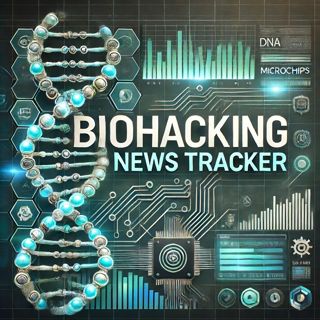
"Biohacking Pioneers Laser Therapy for Hair Revitalization"
Biohacking combines cutting-edge scientific research and self-experimentation to enhance human biology, encompassing a multitude of practices from nutritional changes to high-tech gadgetry. One interesting product in this field is the Kiierr Laser Cap, a non-invasive treatment purported to boost hair growth through low-level laser therapy (LLLT). The Kiierr Laser Cap promises to revitalize thinning hair by stimulating hair follicles at the cellular level, thereby encouraging new growth and thicker, more resilient hair.Low-level laser therapy in devices like the Kiierr Laser Cap operates under the principle that light emitted at specific wavelengths can penetrate the skin and stimulate cellular activity. This process is believed to enhance blood flow and energize hair follicles, potentially reversing the miniaturization of follicles seen in common baldness patterns. The cap is designed for home use, which adds convenience for users looking to incorporate this treatment into their regular routines without frequent visits to medical facilities.Reviews of the Kiierr Laser Cap often highlight user experiences noting improvements in hair density and coverage over several months of use. Nonetheless, as with any biohacking tool, individual results vary, and efficacy can depend on factors such as the pattern and extent of hair loss prior to starting treatment.Aside from actual products, the biohacking community is also expanding its influence through media. An example is the Medical Health Institute's launch of the "Beyond Biohacking Brothers" podcast. The program, led by Miguel Bertonatti, a seasoned biohacker and clinic director, dives into various biohacking strategies. Drawing from a broad spectrum, the podcast covers topics from cutting-edge nutritional interventions to the latest in minimally invasive techniques aimed to optimize personal health and performance.Biohacking, in essence, seeks to decode complex biological processes and offer individuals custom solutions to enhance their health and extend their lifespan. This field, though still evolving, continues to gain traction among those who wish to take a proactive approach to their health, blending technology and biology in unique ways to tackle personal health objectives.This content was created in partnership and with the help of Artificial Intelligence AI
20 Aug 20242min

"$2 Million a Year Biohacker Aims to Reverse Aging"
Biohacking, a trend that merges the values of biology with do-it-yourself (DIY) approaches from technology sectors, is executed by individuals known as biohackers. These enthusiasts often repurpose scientific hypotheses and methods, aiming to optimize and enhance the human body and its performance. A prime example of biohacking's potential is embodied by an individual investing $2 million a year in a bid to reverse his biological age, positioning himself as a "human guinea pig" in the realm of gene enhancement and advanced health optimization.Such biohackers typically use a blend of medical, nutritional, and electronic techniques to manipulate their biology. In the case of this individual, this includes undergoing rigorous and advanced medical treatments not commonly available or approved by standard medical practices. The strategies could range from experimental gene therapy aiming to manipulate DNA sequences for rejuvenation, to less invasive measures like tailored nutritional regimes designed to enhance cellular health. Moreover, heavy investment in state-of-the-art technology may be involved to monitor bodily functions in real-time and adjust the personal biohacking strategies accordingly.While some in the medical community view biohacking with skepticism due to safety and ethical concerns, proponents argue that it represents the next step in human evolution and personal health. They believe that with the right combination of biological and technological intervention, aging can be significantly slowed, or even reversed, contributing to better quality of life and longer lifespans.This individual's approach likely includes a combination of lifestyle adjustments, dietary supplements, nootropics (smart drugs), and possibly more controversial treatments such as parabiosis (the process of having the blood of a younger individual transfused into their system), though specifics are generally kept private for proprietary and personal reasons. However, extensive workouts, including doing 20,000 sit-ups, demonstrate the lengths to which such individuals will go to maintain and enhance their physical health.The ambition to fundamentally alter human biological structures via gene enhancement and other advanced technologies encapsulates a futuristic approach to personal health management. As cutting-edge as it is, professionals in the field advise caution, urging individuals to consider the potential long-term effects and ethical concerns surrounding such extreme biohacking ventures. Nevertheless, it serves as a vivid illustration of modern man's quest to conquer age and optimize life itself through the convergence of science, technology, and sheer will.This content was created in partnership and with the help of Artificial Intelligence AI
18 Aug 20242min

Biohacking Fuels Olympic Dreams Ahead of Paris 2024
As the Paris 2024 Olympics approach, athletes are increasingly turning to biohacking techniques to optimize performance and push their limits beyond traditional training methods. Biohacking, a method of enhancing the human body through scientific and technological advancements, is seeing widespread adoption in the world of elite sports, where the margin between victory and defeat is often razor-thin.Biohacking for athletic performance typically involves making lifestyle and dietary changes, incorporating advanced technology, and sometimes tweaking biological processes directly. This holistic approach aims to maximize every potential aspect of body and mind to gain a competitive edge.### Nutritional GeneticsAthletes are using genetic testing to tailor their diets according to how their bodies respond to different nutrients. These bespoke diets are designed to improve energy levels, speed up recovery times, and boost overall performance. By understanding their genetic markers, athletes can optimize their intake of carbs, fats, and proteins, reduce inflammation, and enhance muscle recovery, all of which are crucial during training and competitions.### Wearable TechnologyIn the realm of biohacking, wearable technology plays a pivotal role. Devices that monitor heart rate, sleep patterns, blood oxygen levels, and even lactic acid levels provide real-time, actionable data that athletes and coaches use to fine-tune training programs. For example, sleep trackers help ensure that athletes achieve the optimal amount of REM sleep required for recovery and performance.### Neurofeedback TrainingNeurofeedback is a form of biofeedback that teaches an individual to change their brain waves. By wearing sensors on the scalp, an athlete can learn to control their brain function, which can help in managing stress, improving concentration, and maintaining mental clarity during high-stakes competitions.### Cryotherapy and ThermoregulationCryotherapy involves exposing the body to extremely cold temperatures for a few minutes, which can help reduce muscle pain and soreness post-intense workouts. Conversely, athletes also use heat therapy to improve circulation and oxygen delivery to muscles. Managing these extremes of temperature enables more efficient recovery and better performance.### Supplement StackingBiological supplements that are legal and safe within sporting regulations are also part of an athlete's biohacking toolkit. These may include nootropics for enhanced cognitive function, or supplements like creatine for increased energy during short bursts of intense activity. Each supplement stack is often customized to the athlete's specific needs and bodily reactions, meticulously tested to observe how particular compounds affect their performance.### Biomechanical FeedbackUsing advanced biomechanics, athletes can refine their techniques to an unprecedented degree of precision. High-speed cameras and motion sensors detect even the slightest inefficiencies in an athlete’s movement, which can be corrected through targeted training. This ensures that every motion is as economical and effective as possible, reducing the risk of injury and improving performance outcomes.The incorporation of biohacking into Olympic-level training signifies a shift towards more scientifically informed athletic practices. Athletes are now capable of not only understanding and monitoring their body’s responses to various stimuli in real time but also adjusting their regimes instantaneously to optimize performance. As the Paris 2024 Olympics draw nearer, the sports world is keenly watching how these advanced methodologies impact the games, potentially leading to new records and unprecedented achievements. These innovations showcase a future where technology and biology blend to bring out the best in human capabilities, setting the stage for an exciting and futuristic Olympic event.This content was created in partnership and with the help of Artificial Intelligence AI
15 Aug 20244min

"Biohacking Pioneers Push Boundaries with Implants, Genetic Mods, and Anti-Aging Protocols"
Biohacking, an ever-evolving frontier where technology and biology converge, is seeing some impressive advancements and feats. One such milestone comes from biohacking magician Anastasia Synn, who recently earned a Guinness World Record for having the most technological implants in the body for a female, with over 50 implants. Synn's achievement highlights the growing trend of integrating technology directly into the human body, aiming not just for enhancement but also for creating new interfaces between humans and machines.Biohacking encompasses a wide range of practices and ideologies, with one critical angle being the alteration of human genes. These genetic modifications can range from simple DIY CRISPR experiments to more sophisticated initiatives aimed to drastically extend human healthspan and capabilities. The integration of these practices demonstrates the underlying principle of biohacking: optimizing human potential by merging biological processes with technological advancements.Further pushing the boundaries of biohacking, figures like Bryan Johnson are exploring anti-aging protocols that involve a combination of dietary supplements aimed at enhancing physical and cognitive functions. Johnson's regimen, known as 'The Biohack Stack,' includes a variety of supplements along with a standard diet that promotes improved health outcomes. This kind of regimented biohacking has gained attention not only for its potential benefits but also for its approach to redefining aging and health maintenance through technologically and biologically integrated solutions.Biohacking's impact is widening as more individuals, from magicians to entrepreneurs, experiment with ways to push the conventional boundaries of human biology using implants, supplements, and genetic modifications. This movement not only fosters personal optimization but also prompts a broader dialogue on the ethical, medical, and societal implications of such deep integration of technology and biology. As biohacking continues to evolve, it will likely challenge and reshape our understanding of what it means to be human in the technologically advanced world.This content was created in partnership and with the help of Artificial Intelligence AI
13 Aug 20242min

"Affordable Red Light Therapy Device Gains Traction with Biohackers"
Biohacking is a growing trend that involves optimizing human performance, health, and well-being through strategic interventions. One of the tools gaining traction with biohackers is the Bon Charge Mini Red Light Device. Known for its affordability and effectiveness, this device stands out as an accessible option for individuals interested in exploring the benefits of red light therapy on a budget.Red light therapy, also known as photobiomodulation, uses specific wavelengths of red and near-infrared light to penetrate the skin and cells. This can help in stimulating cellular processes and repairing damage. It has been scientifically recognized for its potential benefits, which include improved skin health, enhanced muscle recovery, reduced inflammation, and better sleep quality. It can also boost mitochondrial function, critical for energy production and overall vitality.The appeal of the Bon Charge Mini Red Light Device lies in its versatility and cost-effectiveness. While many longevity and biohacking tools can be expensive, making them less accessible to the general public, this device provides a budget-friendly alternative without sacrificing quality.Additionally, its compact size makes it convenient for personal use at home or on the go, enabling users to integrate red light therapy into their daily routines easily. As biohacking practices continue to evolve, tools like the Bon Charge Mini Red Light Device offer promising possibilities for individuals looking to take a proactive approach to their health and well-being, embodying the core principles of biohacking by empowering personal optimization through science-backed methods.This content was created in partnership and with the help of Artificial Intelligence AI
10 Aug 20241min

BIOHACKING SURGES IN POPULARITY, ENTERS MAINSTREAM
Biohacking is a rapidly growing field that blends biology with DIY approaches to enhance physical and mental health. Its popularity has surged among both health enthusiasts and A-list celebrities, catalyzing its emergence in mainstream media and retail spaces."BIOHACKERS Magazine," a leading publication dedicated to this innovative discipline, has become the media partner for RAADFest 2024. The festival is a seminal event that focuses on radical life extension technologies and attracts a global audience eager to explore cutting-edge health and longevity strategies.Biohackers typically use a range of techniques from genetic modifications and nutritional supplements to electronic devices, aiming to optimize human performance and increase lifespan. Among the trending practices in the biohacking community is the use of NAD (nicotinamide adenine dinucleotide) supplements. This form of vitamin B3 is reputed among Hollywood's elite for its potential anti-aging effects by promoting DNA repair and cellular function, thus possibly reversing signs of aging and enhancing energy levels.However, the safety and efficacy of such supplements are subjects of ongoing research. While some studies suggest potential benefits, experts caution against unregulated supplements that promise anti-aging miracles without solid scientific backing. Consumers are advised to consult healthcare professionals before starting any new supplement regimen.Moreover, biohacking's appeal has broadened from exclusive celebrity endorsements to accessibility on the high street, suggesting a shift towards mainstream acceptance. Products and services once limited to privileged circles are now available to a broader audience, making the principles of biohacking more inclusive. Yet, this democratization also urges stricter scrutiny and regulation to ensure these practices are safe and grounded in reliable science.As biohacking continues to evolve, it reflects a broader trend towards personalization in healthcare where individuals take more active roles in tailoring health interventions to fit their unique biological setups. This shift represents a significant move from traditional to more proactive, personalized health management. Biohacking promises not just extended longevity but also improved quality of life, positioning itself at the cutting edge of the health and wellness industry.This content was created in partnership and with the help of Artificial Intelligence AI
8 Aug 20242min

"Biohacking Revolutionizes Personal Health Management, Raising Opportunities and Risks"
Biohacking refers to the practice of managing one's own biology using a combination of medical, nutritional, physical, or electronic techniques. It ranges from simple lifestyle and dietary changes to extreme interventions like implant technology and genetic engineering. The movement has grown significantly, spurred by a community of enthusiasts eager to push the boundaries of human biology to enhance health, performance, and longevity.Tim Gray, often cited as the UK's leading biohacker, explains that biohacking can be as simple as making changes to diet and sleep, or as advanced as using supplements, gadgets, and even therapies that are not yet mainstream. Gray's approach involves a meticulous process of tracking and modifying his body's biochemistry and employing a framework that he claims boosts his overall health and lifespan.Biohacking can be grouped into different categories, each with its own set of methods and tools. "Nutrigenomics" focuses on how food affects one’s genes, advocating for personalized nutrition to help manage and prevent disease. Another method involves "DIY biology," where individuals conduct scientific experiments, such as gene editing, outside traditional environments like academic labs.Despite its growing popularity, biohacking comes with its share of risks and controversies, particularly around experimentation that lacks medical supervision or involves untested procedures. Mainstream healthcare professionals often express concerns regarding the safety and efficacy of certain biohacking methods. For instance, the use of nootropic drugs to enhance cognitive abilities or implanting devices that track health parameters can pose health threats if done improperly.Nevertheless, proponents of biohacking see it as a way of democratizing science and health optimization, enabling individuals to take control of their own health. Events like the annual Health Optimization Summit in the UK, founded by Tim Gray, continue to attract a global audience, showcasing the latest biohacking technologies and practices.As biohacking continues to evolve, it promises possibilities that could revolutionize personal health management. However, it also necessitates a balanced perspective to avoid potential health hazards, underscoring the importance of integrating expert medical advice with biohacking initiatives.This content was created in partnership and with the help of Artificial Intelligence AI
6 Aug 20242min

Biohacking: The Frontier of Biology and Hacking
Biohacking represents the frontier where biology and hacker culture intersect. Biohackers, a diverse group ranging from professional scientists to amateur biology enthusiasts, share a common goal: to explore and influence the biological processes to enhance the human body, extend life spans, and improve quality of life. Their activities span from genetic modification to lifestyle and body enhancements through various technologies. One popular area in biohacking is the use of wearables and implantable devices to monitor body metrics. These technologies provide continuous data on health parameters such as heart rate, glucose levels, and sleep patterns, which biohackers use to optimize their biological functioning. Such data-driven biohacking is aimed at achieving peak physical and mental conditioning. For instance, some biohackers utilize continuous glucose monitoring devices to refine their diets and stabilize blood sugar levels, ultimately seeking an edge in metabolic health.Another ambitious facet of biohacking involves genetic engineering, where biohackers experiment with genetic material. An example includes the use of CRISPR, a groundbreaking gene-editing technique that enables precise alterations to DNA sequences. Some biohackers even perform self-experiments, attempting to modify their genetic code to, for example, increase muscle growth or resistance to diseases. These practices, however, raise substantial ethical and safety concerns, prompting calls for more stringent regulation. Nutrigenomics is another form of biohacking which looks at the interaction between nutrients and genes. It explores how different foods can affect health at a genetic level. By understanding their genetic responses to specific nutrients, individuals can customize their diets to help prevent, mitigate, or cure chronic illnesses. This personalized approach to nutrition predicates a more proactive and informed stance towards one’s health.At the community level, biohackers often congregate in spaces known as 'hacklabs' or 'biohacking spaces' where they share knowledge, tools, and resources. These communal spaces support the ethos of democratizing science, allowing more people to engage with and contribute to biological research and innovation. Here, crafting DIY biology equipment, sharing protocols, and providing educational workshops empower community members to take science into their own hands.Despite its promise, biohacking is not free of criticism and controversy. The main concerns involve safety, as manipulating biological processes can lead to unintended consequences. This is particularly true with genetic experiments that could potentially affect germ lines. Furthermore, the accessibility of biohacking tools and information also raises the specter of biosecurity threats, underscoring the need for ethical introspection and regulatory frameworks. Ultimately, biohacking stretches the boundaries of traditional biology and medicine, offering novel perspectives and solutions for improving life. As this field continues to evolve, it is essential to balance innovation with responsible practices to ensure that biohacking contributes positively to society and human health.This content was created in partnership and with the help of Artificial Intelligence AI
4 Aug 20243min





















